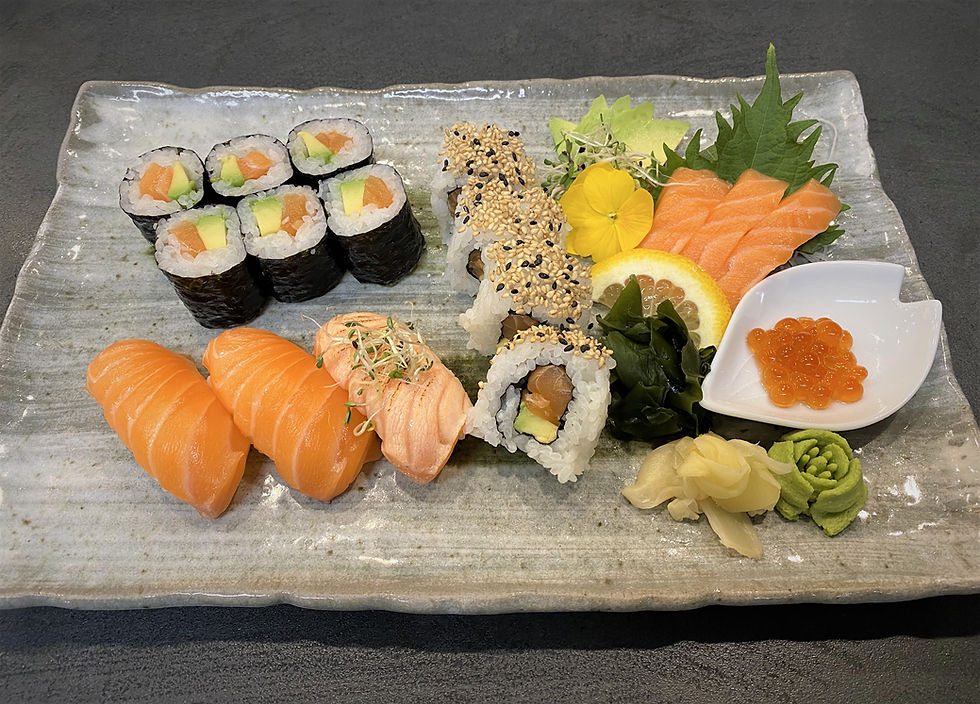The Ultimate Guide to Sushi
- Prävention der Adipositas Gesundheitsberaterin

- 22. Nov. 2023
- 4 Min. Lesezeit

Sushi, the quintessential Japanese cuisine, has taken the world by storm with its exquisite flavors and artful presentation. While many mistakenly believe that sushi is solely raw fish, it is, in fact, a diverse culinary experience that encompasses a wide range of ingredients, techniques, and flavors.
Sushi can be traced back to ancient Japan, where it initially served as a means to preserve fish by fermenting it with rice. Over time, this preservation method evolved into a delicacy enjoyed for its taste and aesthetic appeal. Today, sushi has become an art form where skilled sushi chefs masterfully combine flavors and textures to create edible works of art.
Types of Sushi
Ginger, traditionally served alongside sushi, acts as a palate cleanser, refreshing the taste buds between each delectable bite. Its slightly spicy and sweet flavor profile not only cleanses the palate but also enhances the overall sushi experience. Additionally, the pickled ginger's vibrant pink or pale yellow hues add a visual contrast to the plate, enhancing the aesthetic appeal of the dining experience.
In Japanese dining etiquette, it is common to enjoy a small amount of pickled ginger between different types of sushi to clear the palate and fully appreciate the distinct flavors of each piece. This thoughtful combination of nigiri sushi and pickled ginger exemplifies the artistry and attention to detail that characterize traditional Japanese sushi dining.
Nigiri: The Elegance of Hand-Pressed Sushi
Nigiri sushi, the most widely recognized form of sushi, consists of a small mound of vinegared rice carefully shaped by skilled chefs and topped with a slice of raw fish or seafood. This simple yet elegant creation allows the natural flavors of the fish to shine, creating a harmonious balance of textures and tastes.
Bite-Sized Bites of Deliciousness Maki
Maki, also known as sushi rolls, are crafted by expertly wrapping a layer of seasoned rice and a variety of fillings in a sheet of nori, which is dried seaweed. This meticulous process results in visually appealing and flavorful Maki that are a staple in Japanese cuisine.
These vibrant Maki come in a wide array of options, featuring creative combinations of fish, vegetables, and condiments. The diversity of ingredients allows for a delightful burst of flavors and textures in every bite. From classic rolls like the California roll with avocado, cucumber, and crab, to more adventurous options like spicy tuna or tempura rolls, maki offers a versatile and customizable sushi experience.
The use of nori not only adds a distinct umami flavor to the rolls but also contributes a satisfying crunch, complementing the softness of the rice and the various fillings. Maki sushi is often served with soy sauce and wasabi for dipping, allowing diners to tailor the intensity of flavors to their liking.
Perfect for Plant-Based Palates
Vegetarian sushi is an excellent choice for those with plant-based preferences, featuring fresh vegetables, pickled radishes, and tofu in delightful rolls that offer a mix of colors and flavors. Whether planning a sushi party or enjoying a solo feast, customized sushi platters are a versatile option, tailored to include an assortment of rolls and nigiri to accommodate diverse tastes. In recent years, fusion sushi has gained popularity, creatively combining traditional Japanese ingredients and techniques with elements from other cuisines, resulting in unique and exciting twists on classic flavors, from spicy rolls to tempura-filled creations.
Pairing Perfection: Sake and Sushi
Savoring the delicate flavors of sushi while indulging in the smooth, refined taste of sake is a match made in culinary heaven. The combination of these two traditional Japanese delights creates a harmonious dining experience that is truly unparalleled.
Why Sake and Sushi are the Perfect Pair
Sushi, known for its fresh seafood and delicate flavors, is elevated to new heights when accompanied by the right sake. The complementary characteristics of these two iconic Japanese delicacies create an explosion of flavors on the palate. Whether it's the subtle sweetness of a nigiri or the umami-rich flavors of a maki , sake has the ability to enhance and elevate the taste of sushi, taking the dining experience to a whole new level.
From sweet and fruity to dry and complex, sake encompasses a wide range of flavors and styles. Some popular types of sake include:
Junmai
Made purely from rice, water, yeast, and koji, junmai sake is known for its full-bodied, rich flavor profile.
Ginjo
Highly aromatic and refined, ginjo sake is made using a special brewing process that involves fermenting the rice at colder temperatures.
Daiginjo
Considered the pinnacle of sake brewing, daiginjo sake is made from rice that has been milled to at least 50% of its original size, resulting in an incredibly smooth and delicate flavor.
Finding the Perfect Match
Achieving the perfect pairing of sake and sushi is a delightfully delicate art. Just as different types of sake have distinct flavor profiles, so too do various types of sushi.
Light and Delicate Sushi
Opt for a sake with a clean and crisp flavor profile, such as a junmai or ginjo. These lighter sakes won't overpower the delicate flavors of sushi like sashimi or cucumber rolls.
Rich and Fatty Sushi
For sushi with richer and fattier flavors, such as salmon or tuna rolls, reach for a sake with a fuller body and more robust flavor. A daiginjo or aged sake will complement these bolder flavors perfectly.
Creamy and Unagi Sushi
Sushi rolls that contain creamy fillings or grilled eel pairs exceptionally well with an aged sake or nigori sake, which features a creamy, unfiltered texture.
As you delve into the world of sake and sushi pairings, you will undoubtedly develop your own preferences and favorites.


